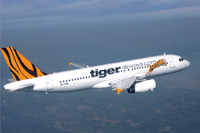 |
|---|
He could not give any interviews for a month after Tiger's 22 January listing on the Singapore Stock Exchange, which helped it raise S$247.7 million ($178.5 million). Observers, however, believe that the carrier could have done more to neutralise some of the negative sentiment that surrounded the listing.
Cynics suggested that the amount raised was far less than the carrier had hoped for. Budget carrier rivals AirAsia and Jetstar announced in mid-January, just when Tiger was promoting its initial public offering, that they were forming an alliance to help them save costs.
The feisty Davis, a 23-year veteran of the airline industry, who was the founding managing director of bmibaby, insists: "We are happy with the amount we raised. Suggestions that we settled for less than what we aimed for [are] simply not true."
Certainly, the first Asian airline IPO since AirAsia was floated in Kuala Lumpur five years ago was a success by most measures. The amount raised was within the target band, the retail and institutional components were oversubscribed, and the stock has risen 14.7% from the issue price of S$1.50 to S$1.72 on 12 March.
Post-listing, Tiger reported a net profit of S$14.1 million for the three months ending 31 December. This marked a turnaround from a net loss of S$7.7 million at the same stage last year. Revenues rose almost 30% to S$139.5 million during the quarter, while costs increased only 3% over the same period.
Both its Singapore and Australia operations were in the black, says Tiger, although it declines to give a breakdown. A lot of this has to do with an aggressive push to keep costs low, giving the carrier an impressive cost per ASK of 4.7 cents.
Tiger plans to use part of the proceeds to pay for new aircraft, increasing its fleet from 19 aircraft today to 33 Airbus A320s by March 2012. These will be based in Singapore and Australia. It plans to eventually operate 68 A320 family aircraft by December 2015, and has 49 on order. Tiger is moving away from leasing aircraft to owning them, saying that this also helps it reduce costs. The Singapore carrier took delivery of its first owned aircraft in January this year.
Operating Margin
"We had a 17% operating margin on a fleet of 17 aircraft. Our competitors don't [have that]," says Davis. "We are a transportation company, which is focused on offering our customers the lowest possible airfares and giving our investors the best return on their investment. The airline industry, historically, has made the big mistake of over-promising and under-delivering. With Tiger, we try to do the reverse. We underpromise and over-deliver."
The budget carrier will also use money raised to fund its network expansion. It plans new services to India, and is expanding the frequency on services to China and Thailand. Tiger is also adding new bases. The Philippines and South Korea have been explored as possibilities, but neither worked out. The main aim, stresses Davis, is profitability. "The trick now is to pick the right opportunity and the right market," he says, before adding, with a smile and a dig at his rivals: "It's not a land grab. It's not about putting a flag on the map."
Turning his attention to AirAsia and Jetstar, he says that their agreement was just "a lot of hot air". The two carriers plan to co-operate on areas where they can cut costs, such as the joint purchase of aircraft and joint bidding for passenger handling service. But Davis says that their subsequent actions contradicted those aims. In January, Jetstar ordered IAE V2500 engines for the 50 Airbus A320s it has on order, while AirAsia's A320s use CFM engines. In February, AirAsia bought a 30% stake in Vietnamese start-up VietJet, which could compete against Jetstar's Vietnamese associate, Jetstar Pacific. "It was nothing more than a publicity stunt in the middle of our IPO. Their subsequent actions show that they are at complete loggerheads with what they said that they plan to do," says Davis.
Making Money
Tiger, he adds, is not about spending money on marketing itself, like AirAsia has with Formula 1 and football sponsorships.
"We are about making money. It's about what gives me the best bang for my buck. We take punctuality very seriously. We take not cancelling flights very seriously. We take not losing your suitcase very seriously. But beyond that, other than getting you there safely, you are not going to get a lot of service," says Davis.
"We want to focus on our business. We are not driven by ego. We are not driven by me being the brand."
Read more on the recent increase in Asian carrier financial market activity here
Source: Airline Business
















